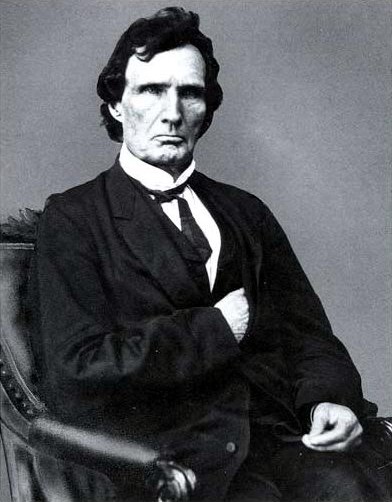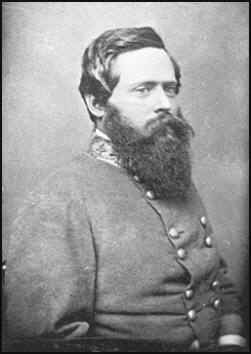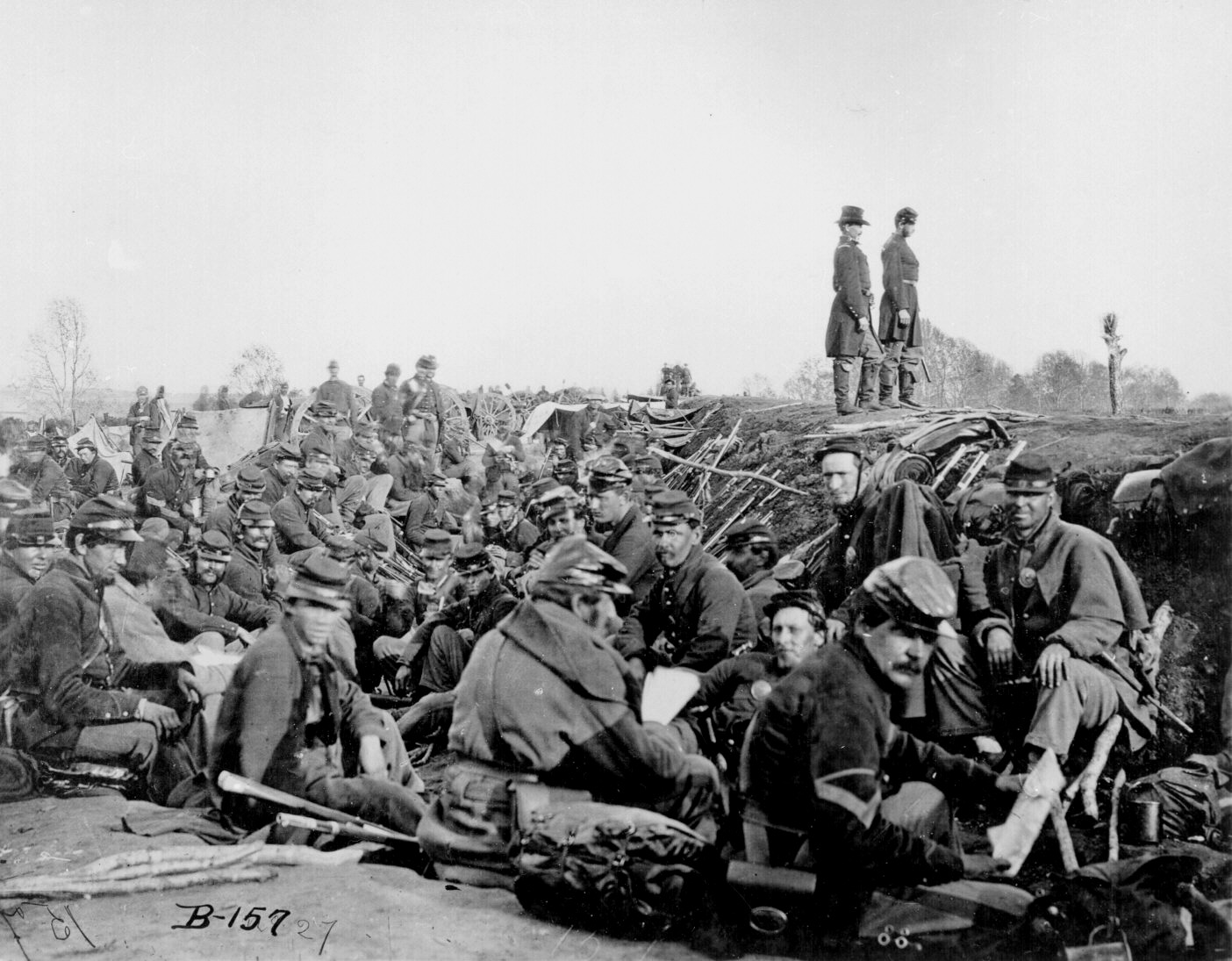|
Charles Griffin
Charles Griffin (December 18, 1825 – September 15, 1867) was a career officer in the United States Army and a Union general in the American Civil War. He rose to command a corps in the Army of the Potomac and fought in many of the key campaigns in the Eastern Theater. After the war, he commanded the Department of Texas during Reconstruction. He was an ardent supporter of the Congressional policies of the Radical Republicans and of freedmen's rights, and controversially disqualified a number of state officeholders in Texas who had supported the Confederate States of America, replacing them with loyal Unionists. Early life and career Griffin was born in Granville, Ohio, the son of Apollos Griffin. He attended the nearby Kenyon College in Gambier, and graduated from the U.S. Military Academy in West Point, New York, placing 23rd out of 38 in the Class of 1847.Eicher, 2001, p. 269. Commissioned as a brevet second lieutenant, he served with the 2nd U.S. Artillery during t ... [...More Info...] [...Related Items...] OR: [Wikipedia] [Google] [Baidu] |
Granville, Ohio
Granville is a Village (United States)#Ohio, village in Licking County, Ohio, United States. The population was 5,946 at the United States Census 2020, 2020 census. The village is located in a rural area of hills, known locally as the Welsh Hills, in central Ohio. It is east of Columbus, Ohio, Columbus, the state capital, and west of Newark, Ohio, Newark, the county seat. The village began as a settlement by European-Americans of Welsh descent. It has long served as a hub for education in the area. It also served as a hotbed for Temperance Movement and Abolitionist activity. Granville is home to Denison University. The village has a number of historic buildings, including Greek Revival structures like the Avery-Hunter House, Avery Downer House, St. Luke's Episcopal Church (Granville, Ohio), St. Luke's Episcopal Church (1837) and others. The Buxton Inn (1812), the Granville Inn (1924), Bancroft House (1834) and Bryn Du Mansion are local landmarks. History Pre-Columbian culture ... [...More Info...] [...Related Items...] OR: [Wikipedia] [Google] [Baidu] |
Battle Of Antietam
The Battle of Antietam ( ), also called the Battle of Sharpsburg, particularly in the Southern United States, took place during the American Civil War on September 17, 1862, between Confederate General Robert E. Lee's Army of Northern Virginia and Union Major General George B. McClellan's Army of the Potomac near Sharpsburg, Maryland, and Antietam Creek. Part of the Maryland Campaign, it was the first field army–level engagement in the Eastern Theater of the American Civil War to take place on Union soil. It remains the bloodiest day in American history, with a tally of 22,727 dead, wounded, or missing on both sides. Although the Union Army suffered heavier casualties than the Confederates, the battle was a major turning point in the Union's favor. After pursuing Confederate General Robert E. Lee into Maryland, Major General George B. McClellan of the Union Army launched attacks against Lee's army who were in defensive positions behind Antietam Creek. At dawn on Se ... [...More Info...] [...Related Items...] OR: [Wikipedia] [Google] [Baidu] |
Confederate States Of America
The Confederate States of America (CSA), also known as the Confederate States (C.S.), the Confederacy, or Dixieland, was an List of historical unrecognized states and dependencies, unrecognized breakaway republic in the Southern United States from 1861 to 1865. It comprised eleven U.S. states that declared Secession in the United States, secession: South Carolina in the American Civil War, South Carolina, Mississippi in the American Civil War, Mississippi, Florida in the American Civil War, Florida, Alabama in the American Civil War, Alabama, Georgia in the American Civil War, Georgia, Louisiana in the American Civil War, Louisiana, Texas in the American Civil War, Texas, Virginia in the American Civil War, Virginia, Arkansas in the American Civil War, Arkansas, Tennessee in the American Civil War, Tennessee, and North Carolina in the American Civil War, North Carolina. These states fought against the United States during the American Civil War. With Abraham Lincoln's 1860 Un ... [...More Info...] [...Related Items...] OR: [Wikipedia] [Google] [Baidu] |
Radical Republican (USA)
The Radical Republicans were a political faction within the Republican Party originating from the party's founding in 1854—some six years before the Civil War—until the Compromise of 1877, which effectively ended Reconstruction. They called themselves "Radicals" because of their goal of immediate, complete, and permanent eradication of slavery in the United States. However, the Radical faction also included strong currents of nativism, anti-Catholicism, and support for the prohibition of alcoholic beverages. These policy goals and the rhetoric in their favor often made it extremely difficult for the Republican Party as a whole to avoid alienating large numbers of American voters of Irish Catholic, German, and other White ethnic backgrounds. In fact, even German-American Freethinkers and Forty-Eighters who, like Hermann Raster, otherwise sympathized with the Radical Republicans' aims, fought them tooth and nail over prohibition. They later became known as " Stalwarts". ... [...More Info...] [...Related Items...] OR: [Wikipedia] [Google] [Baidu] |
Reconstruction Era Of The United States
The Reconstruction era was a period in History of the United States, US history that followed the American Civil War (1861-65) and was dominated by the legal, social, and political challenges of the Abolitionism in the United States, abolition of slavery and reintegration of the former Confederate States of America, Confederate States into the United States. Reconstruction Amendments, Three amendments were added to the United States Constitution to grant citizenship and equal civil rights to the Freedmen, newly freed slaves. To circumvent these, former Confederate states imposed poll taxes and literacy tests and engaged in terrorism in the United States, terrorism to intimidate and control African Americans and discourage or prevent them from voting. Throughout the war, the Union was confronted with the issue of how to administer captured areas and handle slaves escaping to Union lines. The United States Army played a vital role in establishing a Labour economics, free lab ... [...More Info...] [...Related Items...] OR: [Wikipedia] [Google] [Baidu] |
Army Of The Potomac
The Army of the Potomac was the primary field army of the Union army in the Eastern Theater of the American Civil War. It was created in July 1861 shortly after the First Battle of Bull Run and was disbanded in June 1865 following the Battle of Appomattox Court House, surrender of the Confederate Army, Confederate Army of Northern Virginia in April. History The Army of the Potomac was founded in 1861. It initially was only the size of a corps relative to the size of Union armies later in the American Civil War, Civil War. Its nucleus was called the Army of Northeastern Virginia led by Brigadier general (United States), Brig. Gen. Irvin McDowell. It fought and lost the Civil War's first major battle, the First Battle of Bull Run. The arrival in Washington, D.C., of Major general (United States), Maj. Gen. George B. McClellan dramatically changed the makeup of that army. McClellan's original assignment was to command the Division of the Potomac, which included the Department of ... [...More Info...] [...Related Items...] OR: [Wikipedia] [Google] [Baidu] |
Corps
Corps (; plural ''corps'' ; from French , from the Latin "body") is a term used for several different kinds of organization. A military innovation by Napoleon I, the formation was formally introduced March 1, 1800, when Napoleon ordered General Jean Victor Marie Moreau to divide his command into four corps. The size of a corps varies greatly, but two to five divisions and anywhere from 40,000 to 80,000 are the numbers stated by the US Department of Defense. Within military terminology a corps may be: *an military organization, operational formation, sometimes known as a field corps, which consists of two or more division (military), divisions, such as the I Corps (Grande Armée), , later known as ("First Corps") of Napoleon I's ); *an administrative corps (or Muster (military), mustering) – that is a #Administrative corps, specialized branch of a military service (such as an artillery corps, an armoured corps, a signal corps, a medical corps, a marine corps, or a corps of ... [...More Info...] [...Related Items...] OR: [Wikipedia] [Google] [Baidu] |
Battle Of Five Forks
The Battle of Five Forks was fought on April 1, 1865, southwest of Petersburg, Virginia, around the road junction of Five Forks, Dinwiddie County, at the end of the Siege of Petersburg, near the conclusion of the American Civil War. The Union Army commanded by Major General Philip Sheridan defeated a Confederate force from the Army of Northern Virginia commanded by Major General George Pickett. The Union force inflicted over 1,000 casualties on the Confederates and took up to 4,000 prisonersSome historians, such as Noah Andre Trudeau cited later, favor the lower Confederate casualty count of about 605 and lower prisoner count of about 2,400. while seizing Five Forks, the key to control of the South Side Railroad, a vital supply line and evacuation route. After the Battle of Dinwiddie Court House (March 31) at about 10:00 pm, V Corps infantry began to arrive near the battlefield to reinforce Sheridan's cavalry. Pickett's orders from his commander General Robert E. Lee ... [...More Info...] [...Related Items...] OR: [Wikipedia] [Google] [Baidu] |
Siege Of Petersburg
The Richmond–Petersburg campaign was a series of battles around Petersburg, Virginia, fought from June 9, 1864, to March 25, 1865, during the American Civil War. Although it is more popularly known as the siege of Petersburg, it was not a classic military siege, in which a city is Encirclement, encircled with fortifications blocking all routes of ingress and egress, nor was it strictly limited to actions against Petersburg. The campaign consisted of nine months of trench warfare in which Union Army, Union forces commanded by Lieutenant general (United States), Lieutenant General Ulysses S. Grant assaulted Petersburg unsuccessfully and then constructed trench lines that eventually extended over from the eastern outskirts of Richmond, Virginia, to around the eastern and southern outskirts of Petersburg. Petersburg was crucial to the supply of Confederate States Army, Confederate General (CSA), General Robert E. Lee's army and the Confederate States of America, Confederate capi ... [...More Info...] [...Related Items...] OR: [Wikipedia] [Google] [Baidu] |
Overland Campaign
The Overland Campaign, also known as Grant's Overland Campaign and the Wilderness Campaign, was a series of battles fought in Virginia during May and June 1864, towards the end of the American Civil War. Lieutenant general (United States), Lt. Gen. Ulysses S. Grant, general-in-chief of all Union Army, Union armies, directed the actions of the Army of the Potomac, commanded by Major general (United States), Maj. Gen. George G. Meade, and other forces against Confederate States Army, Confederate General (CSA), Gen. Robert E. Lee's Army of Northern Virginia. Although Grant suffered severe losses during the campaign, it was a strategic Union victory. It inflicted proportionately higher losses on Lee's army and maneuvered it into a siege at Richmond in the American Civil War, Richmond and Petersburg, Virginia, in just over eight weeks. Crossing the Rapidan River on May 4, 1864, Grant sought to defeat Lee's army by quickly placing his forces between Lee and Richmond and inviting an ope ... [...More Info...] [...Related Items...] OR: [Wikipedia] [Google] [Baidu] |






